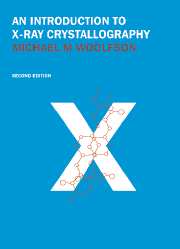Book contents
- Frontmatter
- Contents
- Preface to the First Edition
- Preface to the Second Edition
- 1 The geometry of the crystalline state
- 2 The scattering of X-rays
- 3 Diffraction from a crystal
- 4 The Fourier transform
- 5 Experimental collection of diffraction data
- 6 The factors affecting X-ray intensities
- 7 The determination of space groups
- 8 The determination of crystal structures
- 9 Accuracy and refinement processes
- Physical constants and tables
- Appendices
- Solutions to Problems
- References
- Bibliography
- Index
Preface to the Second Edition
Published online by Cambridge University Press: 11 January 2010
- Frontmatter
- Contents
- Preface to the First Edition
- Preface to the Second Edition
- 1 The geometry of the crystalline state
- 2 The scattering of X-rays
- 3 Diffraction from a crystal
- 4 The Fourier transform
- 5 Experimental collection of diffraction data
- 6 The factors affecting X-ray intensities
- 7 The determination of space groups
- 8 The determination of crystal structures
- 9 Accuracy and refinement processes
- Physical constants and tables
- Appendices
- Solutions to Problems
- References
- Bibliography
- Index
Summary
Since the first edition of this book was published in 1970 there have been tremendous advances in X-ray crystallography. Much of this has been due to technological developments – for example new and powerful synchrotron sources of X-rays, improved detectors and increase in the power of computers by many orders of magnitude. Alongside these developments, and sometimes prompted by them, there have also been theoretical advances, in particular in methods of solution of crystal structures. In this second edition these new aspects of the subject have been included and described at a level which is appropriate to the nature of the book, which is still an introductory text.
A new feature of this edition is that advantage has been taken of the ready availability of powerful table-top computers to illustrate the procedures of X-ray crystallography with FORTRAN® computer programs. These are listed in the appendices and available on the World Wide Web*. While they are restricted to two-dimensional applications they apply to all the two-dimensional space groups and fully illustrate the principles of the more complicated three-dimensional programs that are available. The Problems at the end of each chapter include some in which the reader can use these programs and go through simulations of structure solutions – simulations in that the known structure is used to generate what is equivalent to observed data. More realistic exercises can be produced if readers will work in pairs, one providing the other with a data file containing simulated observed data for a synthetic structure of his own invention, while the other has to find the solution.
- Type
- Chapter
- Information
- An Introduction to X-ray Crystallography , pp. xiiPublisher: Cambridge University PressPrint publication year: 1997

